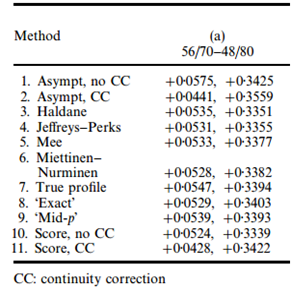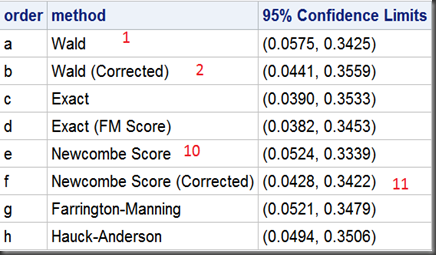A guy notices a bunch of targets scattered over a barn wall, and in the center of each, in the “bulls-eye,” is a bullet hole. “Wow,” he says to the farmer, “that’s pretty good shooting. How’d you do it?” “Oh,” says the farmer, “it was easy. I painted the targets after I shot the holes.” – An Old Joke
Note on how to get the difference between independent binomial proportions using SAS PROC FREQ (tested in SAS 9.3M1). Also, benchmarks took from Prof. Newcombe ’s paper:
Key findings (SAS output):
1. SAS Proc Freq offers 8 ( including 4 of total 11 in Prof. Newcombe ’s paper) methods to compute confidence intervals for difference between independent binomial proportions:
- Wald #1
- Wald (Corrected) #2
- Exact
- Exact (FM Score)
- Newcombe Score #10
- Newcombe Score (Corrected) #11
- Farrington-Manning
- Hauck-Anderson
Note that #1 method is the most popular one in textbook, #10 might be the most wildly used method in industry.
2. There is a big discrepancy in the outputs in the so called “exact” method among SAS Proc Freq and Prof. Newcombe ’s paper. Seems they used different methods (in the same “exact” families) under same name. Needs further investigation.
The SAS codes:
/*
2*2 tableresponse0 response1
group1 56 14
group2 48 32
*/data ci;
input grp res count;
datalines;
1 0 56
1 1 14
2 0 48
2 1 32
;/*
methods:
Exact
Farrington-Manning
Hauck-Anderson
Newcombe Score
Wald
*/
ods select PdiffCLs;
ods output PdiffCLs=ci1;
proc freq data=ci order=data;
tables grp*res /riskdiff (CL=(EXACT FM HA WILSON WALD));
weight count;
exact riskdiff;
run;/*
methods:
Exact (FM Score)
*/
ods select PdiffCLs;
ods output PdiffCLs=ci2;
proc freq data=ci order=data;
tables grp*res /riskdiff (CL=(EXACT));
weight count;
exact riskdiff(fmscore);
run;/*
methods:
Newcombe Score (Corrected)
Wald (Corrected)
*/
ods select PdiffCLs;
ods output PdiffCLs=ci3;
proc freq data=ci order=data;
tables grp*res /riskdiff (CORRECT CL=(WILSON WALD));
weight count;
exact riskdiff;
run;/put them all/
data CI_all;
set ci3 ci2 ci1;
CI=‘(‘||compress(put(LowerCL,8.4))||’, ‘||compress(put(UpperCL,8.4))||’)’;
run;proc sql;
select
case Type
when “Wald” then “a”
when “Wald (Corrected)” then “b”
when “Exact” then “c”
when “Exact (FM Score)” then “d”
when “Newcombe Score” then “e”
when “Newcombe Score (Corrected)” then “f”
when “Farrington-Manning” then “g”
when “Hauck-Anderson” then “h”
else “i”
end as order,
Type “method”,
CI “95% Confidence Limits”
from CI_all
order by order
;
quit;
———————————-
You may be also interested in this post on calculating confidence intervals for single proportion:
Statistical Notes (3): Confidence Intervals for Binomial Proportion Using SAS
using the following 11 methods:
- 1. Simple asymptotic, Without CC | Wald
- 2. Simple asymptotic, With CC
- 3. Score method, Without CC | Wilson
- 4. Score method, With CC
- 5. Binomial-based, ‘Exact’ | Clopper-Pearson
- 6. Binomial-based, Mid-p
- 7. Likelihood-based
- 8. Jeffreys
- 9. Agresti-Coull,z^2⁄2 successes
- 10. Agresti-Coull,2 successes and 2 fail
- 11. Logit

